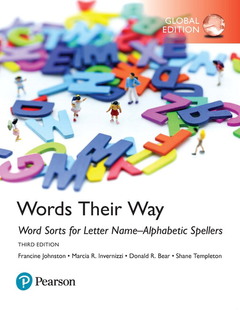Description
Word Sorts for Letter Name-Alphabetic Spellers, Global 3rd Edition (3rd Ed.)
Words Their Way Series
Authors: Johnston Francine, Invernizzi Marcia, Bear Donald, Templeton Shane
Language: English
Subject for Word Sorts for Letter Name-Alphabetic Spellers, Global...:
80.31 €
In Print (Delivery period: 14 days).
Add to cart192 p. · 22x27.5 cm · Paperback
Description
/li>Contents
/li>Biography
/li>Comment
/li>
An essential stage-specific companion to Word Study for Phonics, Vocabulary and Spelling Instruction
This resource presents a complete curriculum of word study for students who are in the letter name?alphabetic stage of spelling development. With over 80 reproducible sorts, specific teacher guidance and many other activities and assessments, it provides a developmental approach to engage students in word study. Together with the other Word Study texts, this resource provides teachers with the knowledge and tools to meet the wide range of needs in today?s classrooms.
All books have been adapted for Australian classrooms with British English spelling and Australian pronunciation. Each title is available in print or as an eBook.
Samples
Preview samples from Word Sorts for Letter Name?Alphabetic Spellers, Global Edition, at the following link: https://www.pearson.com/en-au/schools/media/lc3finjg/words-their-way_alphabetic-spellers-3e_sample.pdf
- Overview
- Sorts for Early Letter Name–Alphabetic
- Unit I: Review Sorts for Beginning Consonants
- Unit II: Same-Vowel Word Families with Pictures
- Sorts for Middle Letter Name–Alphabetic
- Unit III: Digraphs and Blends: Picture Sorts
- Unit IV: Mixed-Vowel Word Families
- Unit V: Short Vowels in CVC Words
- Sorts for Late Letter Name Alphabetic
- Unit VI: Preconsonantal Nasals
- Unit VII: Additional Sorts: Introduction to R-Influenced Vowels and Contractions
- Appendix
About our authors
Francine Johnston is retired from the Department of Teacher Education at the University of North Carolina at Greensboro where she served as Director of Graduate Studies, Coordinator of the Reading Master’s Program and ran a clinic for struggling readers. Francine worked as a first-grade teacher and reading specialist for twelve years before getting her doctorate at the University of Virginia where she first learned about a developmental approach to word study and worked with Dr Marcia Invernizzi to develop word study materials and activities. She consults with school districts across the United States and frequently serves as a professional development speaker. Francine is a co-author of many books, including Word Study for Phonics, Vocabulary and Spelling Instruction.
Donald R. Bear is Professor Emeritus in Literacy and Director of Literacy Centers at Iowa State University and the University of Nevada, Reno. A former elementary teacher, Donald currently researches literacy development with a special interest in students who speak different languages, and he partners with schools and districts to think about how to assess and conduct literacy instruction.
Marcia Invernizzi is Henderson Professor of Reading Education in the Curry School of Education at the University of Virginia. She and her multilingual doctoral students enjoy exploring developmental universals in non-English orthographies. A former English and reading teacher, Marcia extends her experience to working with children who experience difficulties learning to read and write in numerous intervention programs, such as Virginia’s Early Intervention Reading Initiative and Book Buddies.
Shane Templeton is Foundation Professor Emeritus of Literacy Studies in the College of Education at the University of Nevada, Reno. A former classroom teacher at the primary and
Hallmark features of this title
This resource covers a complete curriculum of lessons for students in the letter name–alphabetic stage of spelling development. It engages students in activities to target beginning consonant, same-vowel and mixed-vowel word families, diagraphs and blends, short vowels in CVC words, preconsonantal nasals, r-influenced vowels and contractions. Numerous features support effective teaching and learning, including:
- Over 80 reproducible sorts for students to use in hands-on sorting activities.
- Targeted Learners sections clarify which students will benefit most from the instruction.
- Notes for the Teacher in each unit provide placement guidelines and background information about the features of study. The notes also describe weekly routines to ensure practice and enrichment.
- Extra support for English learners.
- Directions for how to introduce the sort as well as additional teaching tips are included in each lesson. Step-by-step directions for each sort encourage active thinking with questions to guide reflection and generalising.
- High frequency words receive special attention.
- Clearly stated generalisations for each lesson highlight what students will learn.
- Suggestions on how to explore the meaning of words.
- Extend sections provide follow up activities that go beyond sorting and involve students in word hunts, listening exercises and more.
- Apply activities ask students to use the generalisations to develop strategies for spelling unfamiliar words.
- Spell checks for ongoing assessment.
- A pacing chart and goal setting form provides guidelines for placing students in the lesson progression, and sugges




